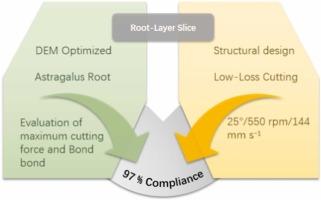Design and optimization of an astragalus slicing machine using computer simulations and design of experiments
IF 6.2
1区 农林科学
Q1 AGRICULTURAL ENGINEERING
引用次数: 0
Abstract
To address the problems of fragmentation, uneven thickness, and high loss rates when slicing root and stem Chinese medicinal materials with low moisture and high fiber content, a novel disk-type Astragalus slicing machine was designed. Cutting mechanics and motion parameters were analyzed and optimized using the Discrete Element Method (DEM). Mechanical properties of three-year-old Astragalus roots from Min County, Gansu Province were determined through tensile, compression, and shear tests, and a DEM model of the root system was established. Cutting edge angle, cutter disk speed, and feed rate were selected as key parameters, with maximum cutting force and bond breakage as evaluation indicators. A response surface methodology was applied to optimize these factors. Simulation results indicated optimal performance at a blade angle of 25°, disk speed of 550 r/min, and feed rate of 144 mm/s, yielding a predicted maximum cutting force of 22.3 N. Prototype testing confirmed these findings (22.7 ± 1.1 N, <8 % deviation), achieving a compliance rate of 97.4 %, slice smoothness of 96.2 %, and a loss rate of only 3.5 %. The optimized design effectively balances frictional and centrifugal forces while reducing contact time, improving both slicing quality and efficiency. This study introduces, for the first time, DEM-based mechanical calibration and response surface optimization in the design of slicing equipment for Chinese medicinal roots. The results provide a technical route from modeling to prototype verification and offer a theoretical basis for developing efficient, high-quality slicing equipment for fibrous medicinal materials.

利用计算机模拟和实验设计对黄芪切片机进行设计与优化
针对低水分、高纤维中药材切片时存在的片状、粗细不均、损耗率高等问题,设计了一种新型圆盘式黄芪切片机。采用离散元法(DEM)对切削力学和运动参数进行了分析和优化。通过拉伸、压缩和剪切试验,对甘肃岷县3年生黄芪根系的力学特性进行了测定,并建立了根系的DEM模型。以切削刃角、刀盘速度和进给速度为关键参数,以最大切削力和粘结断裂为评价指标。采用响应面法对各因素进行优化。仿真结果表明,当叶片角为25°,叶片转速为550 r/min,进给速度为144 mm/s时,切削力最大可达22.3 N。原型测试证实了这些结果(22.7 ± 1.1 N, <;8 %偏差),达到97.4% %的符合率,96.2 %的切片平滑度,损失率仅为3.5 %。优化设计有效地平衡了摩擦力和离心力,同时减少了接触时间,提高了切片质量和效率。本研究首次在中药切片设备设计中引入基于dem的力学标定和响应面优化。研究结果提供了从建模到样机验证的技术路线,为开发高效、高质量的纤维性药材切片设备提供了理论依据。
本文章由计算机程序翻译,如有差异,请以英文原文为准。
求助全文
约1分钟内获得全文
求助全文
来源期刊

Industrial Crops and Products
农林科学-农业工程
CiteScore
9.50
自引率
8.50%
发文量
1518
审稿时长
43 days
期刊介绍:
Industrial Crops and Products is an International Journal publishing academic and industrial research on industrial (defined as non-food/non-feed) crops and products. Papers concern both crop-oriented and bio-based materials from crops-oriented research, and should be of interest to an international audience, hypothesis driven, and where comparisons are made statistics performed.
 求助内容:
求助内容: 应助结果提醒方式:
应助结果提醒方式:


